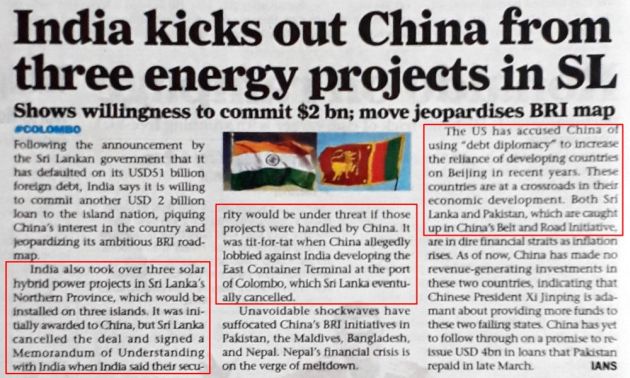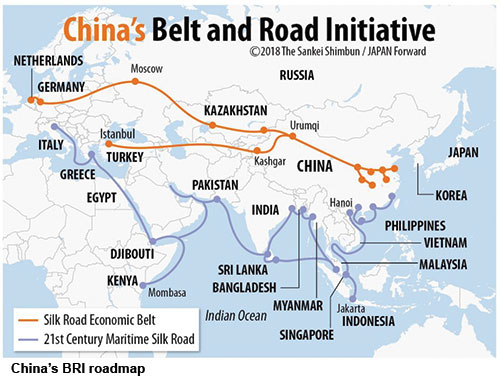On the back of Russia’s invasion of Ukraine, many companies in USA and EU have shut down their operations in Russia, effectively stopping supplies of their products and services to the invader. The West has kicked out many Russian banks from the global payment messaging network SWIFT, which has made it very difficult for Russia to conduct global trade. Google has disabled Google Pay, thus bricking the most popular method of payments used in Moscow Metro, and stranding millions of commuters in the process.
To avoid similar fate, there are calls all over Twitter and LinkedIn for India to develop its own technologies.
India really needs to get its own tech stack. Western companies with their tech hegemony can't be trusted. What is to stop Google from doing this to India, of ordered by the US State Department? https://t.co/XnRfHoDJWZ
— Arun Krishnan 🇮🇳 (@ArunKrishnan_) April 19, 2022
Historically, India has never gone out and invaded other countries. So, I don’t see how the Russia-Ukraine situation can be extrapolated to India. But, assuming for the sake of argument that these people know something that we don’t, their knee-jerk reaction is totally out of sync with the reality of modern times.
Let’s see what happened to similar calls for self-reliance in the past.
- The US government denied government of India’s request for GPS data for Kargil in 1999. GoI decided to develop its own satnav called NAVIC. (Source: Wikipedia). 23 years later, India still runs on Google Maps and GPS. (For the uninitiated, GPS is owned by the US Department of Defence.)
 In How Does Turn By Turn Navigation Work?, I wrote about the Dhruva processor being developed by my alma mater IIT Bombay. At the time, it was mandated that smartphones and other navigation devices sold in India should use the Dhruva + NAVIC combo. Nobody talks about Dhruva or NAVIC now. I’ve not come across any evidence that mobile devices in the Indian market have Dhruva and NAVIC.
In How Does Turn By Turn Navigation Work?, I wrote about the Dhruva processor being developed by my alma mater IIT Bombay. At the time, it was mandated that smartphones and other navigation devices sold in India should use the Dhruva + NAVIC combo. Nobody talks about Dhruva or NAVIC now. I’ve not come across any evidence that mobile devices in the Indian market have Dhruva and NAVIC.- 30 years after email technology went mainstream, how many Indian companies use Indian email software? Even government agencies use Gmail e.g. Ministry of Health & Family Welfare (ncov2019@gmail.com).
- While UPI is Made in India, consumers don’t use UPI directly. Instead, they access UPI via frontend apps. Over 80% of UPI volumes are driven by two foreign apps, namely, Google Pay and Walmart PhonePe. This is despite the fact that there are 40+ Indian UPI apps. Memory serves, UPI was languishing until Google Pay and Walmart PhonePe jumpstarted its usage and took its adoption to the next level.
Now let’s consider the underlying tech stack used to build UPI, RuPay, CoWIN and other Atmanirbhar Bharat success stories. They comprise components like
- OS e.g. Windows, Linux
- RDBMS e.g. Oracle, mySQL
- Programming Language e.g. Java, Python
- Framework e.g. Struts, Bootstrap
- TLD e.g. .com, .net
- DNS e.g. 52.66.148.37
- Cloud infra / Hosting e.g. AWS, Azure / Hostgator, Rackspace
- Servers e.g. Dell, HPE
- Storage e.g. EMC, HPE
- Networking e.g. Cisco, Juniper.
Do you see a single Indian product in the above list? I thought so, too.
"Oracle Cloud Infrastructure (OCI) business saw rapid growth with adoption by NITI Aayog, PM Gati Shakti & ONDC" ~ https://t.co/oB308pmSsw.
Exhibit A: Underlying tech stack used to build many Atmanirbhar Bharat success stories is owned by foreign / US companies.— Ketharaman Swaminathan (@s_ketharaman) April 3, 2023
To those who advocate that India should build backup options to the above building blocks, it’s impossible:
“We also should continue to build backup options however slow it may be.”It’s not a question of slow (or costly). It is IMPOSSIBLE. Even if India somehow defies 1000 years’ historical performance and manages to build its own OS, RDBMS, PL, etc., it can’t build DNS, SWIFT, TLD, and other building blocks of payment or any other application since they are part of global internet infrastructure and are not built by any one country. Individual countries wield control over them not by building them but via other means like having seats in their governing bodies, etc. In short, the paradigm of international geopolitics, especially as related to technology, has shifted from Project Manager mode (where everybody reports to a project manager who is responsible for the success of the project) to Program Manager mode (who is responsible for the success of the program even though nobody reports to him or her). To that extent, membership and presidency of international alliances like G20 are a step in the right direction.
While foreign powers cannot fool around with UPI or RuPay directly, they can render these payment products ineffective by bricking their underlying components listed above. As we saw earlier, the US State Department stranded Russian commuters not by sabotaging the backend rails owned by Russia but by bricking GPay, which runs on top of those rails.
Not blaming anyone but it would be a big mistake to allow Faux Patriotism to delude us into missing the reality.
How, then, does India safeguard its interests?
Going by USA and China, the only two superpowers in the world today, the answer to that question goes beyond self-reliance.
Over 90% of goods on American shelves are Made in China. These include products from Apple, Dell, HP, and many other American companies (ditto American products across a wide array of other industries but I’m sticking to technology in the present context since the trigger for this post is America’s tech stack).
China imports natural resources from Africa, Australia, Spain, and so on.
Going by that, neither USA nor China is self-reliant.
But both nations are global superpowers. How did they achieve that status?
I’m no international relations expert but based on my observation of global geopolitics as the proverbial innocent bystander, I believe that a nation acquires clout on the global stage from three things:
- Size of its economy
- Its position in global supply chain
- Packaging of its expansionist tendencies.
USA and China are trillion-dollar economies.
USA produces technology that is used in tech / non-tech products worldwide. By turning off its underlying tech, USA can cancel products and services owned by other countries.
While China has its own search engine, USA can brick it anytime by disabling the components of its tech stack that are non-Chinese. But USA is unlikely to do that because China can retaliate by shutting down production of American goods.
@s_ketharaman: China’s self-reliance in technology is exaggerated. Fact is China depends on USA for OS, RDBMS and other tech stack components. Testimony: China buys 3X as much technology from Microsoft, Oracle, SAP, et al as India.
China has acquired strategic assets all over the world as part of its Belt and Road Initiative (BRI). These include an Airport in Uganda, a Harbor in Spain, many Solar Power Plants in Sri Lanka.
If these nations refuse to export raw materials to China, China can shut down their airports and harbors, thus blocking these nations from exporting anything to anywhere.
India is a trillion-dollar economy. So, like USA and China, it checks the first box of being a superpower.
In theory, India can manufacture / develop the local equivalent of Dell / HPE servers, Windows / Linux operating systems, Oracle / mySQL RDBMS, AWS / Azure cloud infra, and other hardware and software products.
But, as explained earlier, it’s not possible, even in theory, for India to create local companies to replace the services provided by SWIFT, ICANN, and other global agencies. Or locally source all the raw materials required to manufacture all the Make In India stuff.
But all is not lost.
As we saw earlier, the only two superpowers in the world today acquired global clout not by making everything locally but by embedding themselves in the global supply chain with the ownership of technology, manufacturing and strategic assets all over the world.
India can do the same.
But it will require a change in mindset.
 The credo “You do your own thing, I’ll do my own thing, live and let live” worked when supply chains were local.
The credo “You do your own thing, I’ll do my own thing, live and let live” worked when supply chains were local.
But in today’s world of global supply chains, which have even spread to military weapons, peaceful coexistence comes from active engagement with other nations, not passive detachment.
Historically, MAD (Mutually Assured Destruction) has been the only leverage against nuking.
By developing nuclear weapons decades ago, India got MAD literally.
It should get the economical significance of MAD now.
That can only happen by making the rest of the world depend on India for some vital inputs.
Good news is India is taking its first expansionist steps by buying strategic assets outside the country.
As reported by Economic Times recently, India has taken over three solar hybrid power projects in Sri Lanka in return for committing $2 billion dollars to bail Sri Lanka out from its debt crisis.
I hope India gets an airport and a harbor or two in exchange for the next round of bailout!
India also has its IT Services and BPO industries.
It’s fashionable for everyone and his dog in India to dunk on Indian IT Services and BPO workers as “coolies”. Yes, as I myself highlighted in Indian IT Industry Needs Better Quality Sellers & Marketers, Not Engineers – Part 1, Indian IT Services and BPO workers do lowend work. To that extent, they may be a cog in the wheel. But, as the old saying goes, “For want of a nail the kingdom was lost”. So, even if they’re just a cog, removing them can bring the entire machinery crashing down.
Going forward, as the nation takes steps to gradually reduce its dependence on foreign technologies and raw materials, IT Services and BPO workers can backstop moves by foreign powers to brick vital products and services inside India. Indians should appreciate that these coolies provide more clout for India on the global stage than anybody else does.
As an aside, many people wonder why India cannot gain global clout with products.
It can.
In fact, as a part of Atmanirbhar Bharat, it should.
But it won’t happen overnight.
The Founder CEO of Zoho, a global Top 10 CRM product out of India, estimates that it will take 10-20 years for India to be technologically self-reliant and economically strong.
@svembu: India (must become) technologically self-reliant and economically strong. If we make a sustained and focused effort, it would take us 10-20 years to achieve technological parity.
To appreciate why it would take this long to achieve technological parity, consider the following:
As far back as 1995, nearly 70% of goods in American supermarket shelves were Made in China (today, the figure is close to 90%). However, even today, less than 10% of them are Chinese products.
It’s way more difficult to sell your country’s products all over the world than to manufacture the whole world’s products in your country. As they say, in a capitalism, product / manufacturing is tablestakes, it’s sales / marketing / distribution that provide the differentation.
Actually, when it comes to the IT industry, it’s not that easy to sell your country’s products even within your own country. Testimony: Foreign companies dominate almost all enterprise software categories in India, as I highlighted in Calling BS Of The “Indian Market Is Big Enough For Indian Companies” Myth. Examples: SAP in ERP, Salesforce in CRM, Microsoft in Desktop OS and Office Automation, and so on.
And it’s not for lack of trying. When I joined a leading Indian IT hardware company in the late 1980s, it had a sister company that made software. Among other products, it had a spreadsheet called 4-5-6 inspired by Lotus 1-2-3, which was the leading spreadsheet software in the world at the time. Unable to make much headway, the product died and a little later, the software products company itself shut down. The hardware company pivoted to IT services and is amongst the Top 5 IT companies in India today.
Of course, you need to produce the product but you get clout on global stage only when other countries are dependendent on your product i.e. by placing yourself in a critical position on the global supply chain.#MAD #Russia #Germany #GDP https://t.co/siAb7TPmlP
— Ketharaman Swaminathan (@s_ketharaman) April 24, 2022
But it’s not only India. Virtually every country in the world depends on US technology. In all likelihood, the aforementioned three MNCs are market leaders in the respective software categories even in many countries outside India.
Ergo, it’s not pragmatic to bank on products in the short to medium term.
India will need to grow its GDP, acquire strategic assets all over the world, and leverage its IT Services industry to gain clout on the global stage for the forseeable future.
UPDATE DATED 24 JUNE 2023:
Just realized that the original post does not adequately emphasize a key point about technology, namely that it’s only an enabler.
Savvy businesses use technology to drive business outcomes. They seek to get a (say) 10X multiple in incremental revenues, profits, market cap, and other outputs for every X dollars they spend on technology inputs.
Does it matter whether the X is spent on the SAPs and Oracles – as it was in the case of the Reliances and M&Ms and ONGCs and other Indian megacompanies – or on Indian products?
No. Either way, they emerge 9X richer as long as their technology transformation project is successful.
While Indian Tech Bros would benefit if the X dollars were spent on Indian products, many Indian conglomerates will tell them in private that they were not so confident of reaping the 10X returns by implementing Indian products in critical categories like ERP.
So, from a purely transactional point of view, India Inc and India Nation are better off with the $X spent on foreign technology.
Then there are other benefits to India from the use of foreign products:
- Indian companies listing abroad tend to enjoy higher valuations by implementing SAP et al
- Indian companies raising funds from overseas institutional investors (aka FII / FPS) tend to get lower interest rates by using Oracle Financials et al
- Technology transfers are easier if the Indian partner uses the same enterprise software as the overseas principal.
This can change only if India bans investments and technology transfers from abroad.
Not only would such a move prove disastrous for the Indian economy but it would also backfire on Indian Tech Bros.
As has been proven many times in the last 15-20 years, Indian investors accord way lower valuations to Indian startups compared to foreign VCs. So any move to cut off foreign funding will throw cold water on the plans for Indian Tech Bros to get nosebleed valuations from the Sequoias and Tiger Globals and Accels of the global VC world.
I have no problems with the “get rich quick” schemes of Indian Tech Bros but that doesn’t mean they should be allowed to spread misinformation and resort to faux patriotism to disguise their hidden agenda.
Exhibit 1:
ChatGPT has a free plan. An overwhelming majority of its users pay nothing to use it.
OTOH going by outcry about loot by Swiggy Zomato et al, there's no guarantee that Indian company serves Indians better.
Feel free to spread misinformation but don't drag Faux Patriotism into it.— Ketharaman Swaminathan (@s_ketharaman) June 20, 2023
Exhibit 2:
That's Faux Paranoid BS. During the 30 year period when global tech leaders have also become tech leaders in India, India has become richer, not poorer. End of the day, tech is only enabler. You can spend 1X on foreign tech and make 10X on PLBS, you'll still come out 9X richer.
— Ketharaman Swaminathan (@s_ketharaman) June 24, 2023


